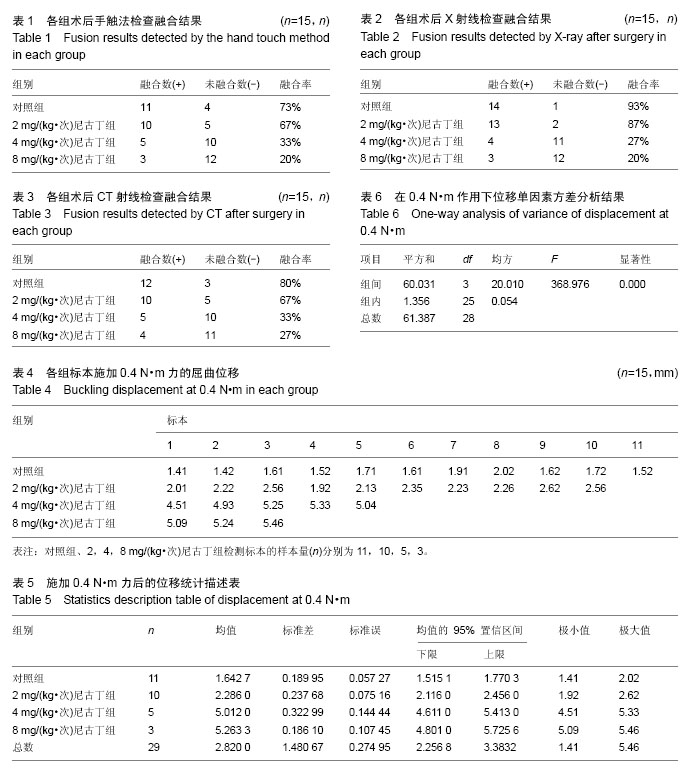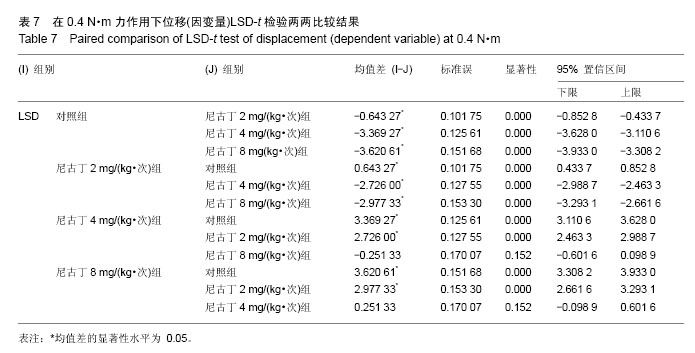| [1] Katz JN,Spratt KF,Andersson GB,et al. Epidemiology introduction. 1995 Focus Issue Meeting on Fusion. Spine.1995;20(24):76-77.
[2] Henningfield JE,Fant RV,Buchhalter AR,et al. Pharmacotherapy for nicotine dependence.CA Cancer J Clin. 2005;55:281-299.
[3] Sandén B, Michaëlsson K, Försth P, et al. Smokers show less improvement than non-smokers 2 years after surgery lumber spinal stenosis. Swed Spine, 2011: 1059-1064
[4] Blumenthal S,Baker J,Dossett A,et al.The role of anterior lumber fusion for internal disc disruption.Spine. 1986;13:566-569.
[5] Brown CW, Orme TJ, Richardson HD. The rate of pseudarthosis(surgical nonunion) in patients who are smokers and patients who are nonsmokers:A comparison study. Spine. 1983;8: 942-943.
[6] Hanley E,Levy J.Surgical treatment of isthmic lumbosacral spondylolisthesis,analysis of variables infulencing results.Spine. 1989;14:48-50.
[7] Morone MA,Boden SD.Experimental posterolateral lumbar spinal fusion with a demineralized bone matrix gel.Spine. 1998;23:159-167.
[8] 蔡宏歆,范顺武,赵凤东.腰椎椎间融合术后融合评价方法和标准[J]. 国际骨科学杂志,2007,28(1):22-25.
[9] Baramki HG, Steffen T, Lander P, et al. The efficacy of interconnected porous hydroxyapatite in achieving posterolateral lumbar fusion in sheep. Spine. 2000; 25(9):1053-1060.
[10] Rocca M,Fini M,Grggi T, et al.Biomechanicals in spinal fixation.An experimental animal study to improve the performance. Int J Artif Organs. 2000; 23(12):824-830.
[11] Foster MR,Allen MJ,Schoonmaker JE, et al. Characterization of a developing lumbar arthrodesis in a sheep model with quantitive instability. Spinal J. 2002;2(4):244-250.
[12] Olinger A,Vollmar B,Hildebrandt U,et al.Experimental development and validation of a technique for lumbar endoscopic and open surgery in alive porcine model. Surg Endosc. 2000;14(9):844-848.
[13] 关凯,时述山,孙天胜,等.兔腰椎融合三种手术方法的比较[J]. 中国比较医学杂志,2003,13(1):33-35.
[14] Boden SD,The biology of posterolateral lumbar spinal fusion. Orthop Clin North Am.1998;29:603-619.
[15] Boden SD,Schimandle JH,Hutton WC.An experimental lumbar inter transverse process spinal fusion model:Radiographic, histologic,and biomechanical healing characteristics. Spine. 1995;20:412-420.
[16] Schimandle JH,Boden SD. The use of animal models to study spinal fusion. Spine. 1994;19:1998-2006.
[17] Cook SD, Salkeld SL, Patron LP. Low-intensity pulsed ultrasound improves spinal fusion. Spine J. 2001;1: 246-254.
[18] Boden SD.Overview of the biology of lumbar spine fusion and principles for selecting a bone graft substitute.Spine. 2002;27(16Suppl 1):S26-31.
[19] Aynaci O, Onder C, Piskin A. The Effect of Ultrasound on the Healing of Muscle-Pediculated Bone Graft in Spinal Fusion. Spine. 2002;27(14):1531-1535.
[20] 吕以仙.有机化学[M].北京:人民卫生出版社,2004:82.
[21] 张锦楠.医用化学[M].北京:人民卫生出版社, 2001: 176-177.
[22] 陈雪泥.让吸烟者从我们这一代开始后继无人[J].化学教学,2003,1(2):1-2.
[23] Slemenda CW. Cigarettes and Skeleton. N Engl Med. 1994;330(6):387.
[24] Krall EA,Dawson HB.Smoking increase bone loss and decrease intestinal calcium absorption. J Bone Miner Res. 1999;14(2):215-220.
[25] Vogel JM, Davis JW, Nomura A, et al. The effects of smoking on bone mass and the rates of bone loss among eldery Japanese-American men. J Bone Miner Res. 1997;12(9):1495-1501.
[26] Krall EA. Dawson Hughes B:Smoking and bone loss among postmenopausal woman. Bone Miner Res. 1991;6:331-338.
[27] 田心义,肖四旺.骨折诊断与治疗选择[M].北京:人民军医出版社,2005:6.
[28] Frost HM.Wollf’s law and bone’s structural adaptation to mechanical usage. Agle Orthop. 1996;64(3):175.
[29] 赵怀志,郝华,卢明书,等.X射线片骨痂的定量探讨与应用[J].中国中医骨伤科杂志,1994,2(4):8.
[30] 吕玉琦,庞俊.测量桡骨远端骨折骨痂生长的微机图像分析系统[J].中华放射学杂志,1993,27(7):472.
[31] 张建国,夏家骝,李华滢,等.周期性载荷对实验性骨折愈合影响的图像分析[J].中华骨科杂志,1995,15(4):220.
[32] Sato T,Abe T,Nakamoto N,et al. Nicotine induces cell proliferation in association with cyclin D1 up-regulation and inhibits cell differentiation in association with p53 regulation in a murine pre-osteoblastic cell line. Biochem Biophys Res Commune. 2008;377(1): 126-130.
[33] Rothem DE,Rothem L,Soudry M,et al.Nicotine modulates bone metabolism associated gene expression in osteoblast cells. Bone Miner Metab. 2009;27:555-561.
[34] Rothem DE,Rothem L,Dahan A,et al.Nicotine modulation of gene expression in osteoblast cells,MG-63.Bone. 2011;48:903-909.
[35] Skott M,Andreassen TT,Ulrich-Vinther M,et al.Tobacco extract but not nicotine impairs the mechanical strength of fracture healing in rats. Orthop Res. 2006; 24(7):1472-1479.
[36] 白冰,朱静涛,钟丽芳.烟草影响人成骨细胞生物学性能机制的研究[J].口腔医学,2010,30(1):35-37.
[37] Glowacki J,Schulten AJ,Perrott D,et al. Nicotine impairs distraction osteogeneses in the rat mandible. Int J Oral Maxillofac Surg. 2008;37(2):156-161.
[38] Zheng LW, Ma L, Cheng LK. Changes in blood perfusion and bone healing induced by nicotine during distraction osteogenesis. Bone. 2008;43(2):355-361.
[39] Iwaniec UT,Cullen F. Effects of Nicotine on Bone and Calciotropic Hormones in Growing Female Rats.Calif Tissue Int. 2000;67:68-74.
[40] Theiss SM, Boden SD, Hair G, et al. The effect of nicotine on gene expression during spine fusion. Spine (Phila Pa 1976). 2000;25(20):2588-2594.
[41] Forrest CR,Xu N,Pang CY. Evidence for nicntine-induced skin flap ischemic necrosis in the pig. Can Physiol Pharmacol. 1994;72(1):30-38.
[42] Krall EA, Dawson HB. Smoking and bone loss among postmenopausal women. Bone Miner Res. 1991;6: 331-338.
[43] Reitstetter R. Dependence of nicotinic acetylcholine receptor recovery from desensitization on the duration of agonist exposure. Pharm Exp Therap. 1999;289: 656-660.
[44] 秦宏敏,李强,胥毅,等.尼古丁对骨髓间充质干细胞碱性磷酸酶活性的抑制作用[J].中国临床康复,2005,9(2):76-77.
[45] 刘卫平,耿华鸥,周磊.尼古丁对大鼠颅骨缺损修复效能的影响[J].中国口腔种植学杂志,2006,11(3):116-118.
[46] 王勇平,陈根元,末建民.吸烟大鼠骨折愈合过程中骨痂含量的变化[J].中国组织工程研究与临床康复,2008,12(50): 9889-9892.
[47] 冯元桢,主编.生物力学[M].北京:科学出版社,1983.
[48] Liu Yk,Ray G,Hirsch C.The resistance of the lumber spine to direct shear. Orthop Clin North Am.1975;6: 33-49.
[49] Scholten R, Svensson NL, Wood RD. Three dimensional Stress analysis of the human femur. Comput Biol Med.1977;6:130.
[50] Turner MS,Clough RW,Martin HC,et al.Stiffness and deflection analysis of complex structure.J Aero Sci. 1956;23:805.
[51] 夏荣,赵云凤.有限元法及其进展[J].中国口腔种植学杂志,1997,2(2):96-101. |
.jpg)



.jpg)